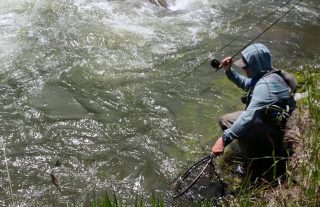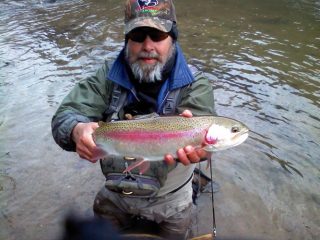
With cooler temperatures here in Western North Carolina, fly fishing tactics for trout will change. The wintertime can concede some great trout fishing, but what worked in the fall won’t necessarily be as successful during the winter. Not to say that you have to reinvent the wheel but where you fish, what you fish, when you fish, and how you fish, will play a big part in your success on the water. It’s one of my favorites times of the year to fish just because most of the “fair weather” anglers stay inside and you have the river all to yourself.
When you’re picking what water type to fish during the winter, there are a couple of things you’ll need to consider. First and foremost, bug activity slows down during the wintertime. This, in turn, is going to affect where trout are going to hold. The productive pocket water that held trout during summer and fall will not hold near as many fish. Why? Because there are not enough bugs coming off to keep the fish there. The more productive water is going to be your slower, deeper troughs and pools. Why? Because that’s where most of your bug activity is happening.

Wintertime fly selection plays an important role as well. Matching the hatch to what is happening is a good place to start. If midge are hatching, then it wouldn’t be a bad idea to throw a midge pattern. Same thing goes for BWOs. Attractor patterns are even more crucial to your wintertime success. Eggs, worms, stoneflies, and mops are all attractor patterns that will move fish to eat even when cold-°©‐water temps have them lethargic. Trout tend to hold deeper during the winter so flies that cut down through to the mixing zone are just as important. A great wintertime standby is an egg fished with a zebra midge. During these cooler months, the days are shorter and your window of primetime fishing gets smaller. So there is no need to be on the water at the break of dawn. The ideal time to fish is midday. 10am to 3pm is usually going to be when the fish are most active, due to the rise in water temperature. Bug activity is usually highest during this time frame, which makes for happier fish, as well.
Since the fish are holding deeper and more lethargic, nymphing is usually going to be the more productive method during the winter months. Tightline nymphing, dry dropping, and suspension devices can all produce at these times. When deciding which method to use, let the conditions dictate that decision. What are your current flows? How deep is the water? What is the clarity of the water? Let the answers to these questions help make your decisions. Good Luck and if you have any questions on the subject feel free to go to
Michael L. Yelton can be reached at The Granddaddy Fly Fishing Experience, LLC located in Lake Lure, NC by email at info@granddaddyflyfishing.com, by phone at (828) 980-3554, or at his website at www.granddaddyflyfishing.com.